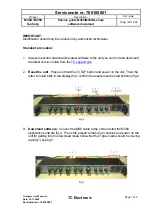
301
8271D–AVR–05/11
ATmega48A/PA/88A/PA/168A/PA/328/P
Note:
1. The default value of SUT1...0 results in maximum start-up time for the default clock source.
See
for details.
2. The default setting of CKSEL3...0 results in internal RC Oscillator @ 8MHz. See
for details.
3. The CKOUT Fuse allows the system clock to be output on PORTB0. See
for details.
4. See
”System Clock Prescaler” on page 36
for details.
The status of the Fuse bits is not affected by Chip Erase. Note that the Fuse bits are locked if
Lock bit1 (LB1) is programmed. Program the Fuse bits before programming the Lock bits.
28.2.1
Latching of Fuses
The fuse values are latched when the device enters programming mode and changes of the
fuse values will have no effect until the part leaves Programming mode. This does not apply to
the EESAVE Fuse which will take effect once it is programmed. The fuses are also latched on
Power-up in Normal mode.
28.3
Signature Bytes
All Atmel microcontrollers have a three-byte signature code which identifies the device. This
code can be read in both serial and parallel mode, also when the device is locked. The three
bytes reside in a separate address space. For the ATmega48A/PA/88A/PA/168A/PA/328/P the
signature bytes are given in
Table 28-9.
Fuse Low Byte
Low Fuse Byte
Bit No
Description
Default Value
7
Divide clock by 8
0 (programmed)
CKOUT
6
Clock output
1 (unprogrammed)
SUT1
5
Select start-up time
1 (unprogrammed)
SUT0
4
Select start-up time
0 (programmed)
CKSEL3
3
Select Clock source
0 (programmed)
CKSEL2
2
Select Clock source
0 (programmed)
CKSEL1
1
Select Clock source
1 (unprogrammed)
CKSEL0
0
Select Clock source
0 (programmed)
Table 28-10.
Device ID
Part
Signature Bytes Address
0x000
0x001
0x002
ATmega48A
0x1E
0x92
0x05
ATmega48PA
0x1E
0x92
0x0A
ATmega88A
0x1E
0x93
0x0A
ATmega88PA
0x1E
0x93
0x0F
ATmega168A
0x1E
0x94
0x06















































